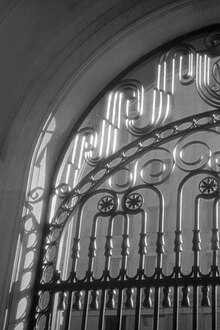Jenő Dulovits
Jenő Dulovits (born June 22, 1903 in Budapest ; † July 24, 1972 there ) was a Hungarian photographer, film cameraman and designer of photo cameras and accessories.
life and work
Jenő Dulovits was a teacher by profession. He dealt with 35mm photography and mainly used a Contax rangefinder camera .
He invented a development method for 35mm black and white films that bridged strong contrasts, e.g. B. backlit photography, made possible. He used a developer according to the following recipe:
- 4.8 g Metol ,
- 180 g crystalline (or 90 g anhydrous) sodium sulfite ,
- 6.4 g potassium metabisulphite ,
- 800 cm³ of water (fill up to 1000 cm³ of solution).
This developer allowed for a moderate overexposure that showed shadow details without flattening the highlight details with total blackening. The lights remained brownish translucent in the negative. The developer produced balanced, fine-grain negatives .
Jenő Dulovits, together with Miklos Tóth, invented the Duto soft focus attachment in 1932, which created blurred light fringes around the top lights on high-contrast subjects (e.g. backlit photos ). The Duto soft focus attachment consisted of a colorless flat glass pane with etched concentric rings that deflected part of the light rays. Similar lens attachments are also offered by photo dealers today. You can replace special soft-focus lenses such as the “Imagon” from Rodenstock at low cost.
In collaboration with the Budapest optical works Gamma, Jenő Dulovits first designed a 35mm camera for the reduced format 24 × 32 mm with a telescopic viewfinder "Dufo", and then a single -lens reflex "Duflex" with an automatically folding mirror and automatic aperture. The viewfinder was with a Porro prism (no pentaprism equipped). The "Duflex" camera was patented on August 23, 1943. Because of the war conditions, the first "Duflex" cameras were only manufactured in 1947 by the Hungarian state-owned MOM camera works.
Dulovits died on July 24, 1972 at the age of 69 in his native Budapest, and found his final resting place in the local Farkasréti cemetery ( Hungarian Farkasréti temető ).
Books
- Jenő Dulovits: Light contrasts and how to overcome them . The gallery, Vienna 1937.
- Jenő Dulovits: My technique - my pictures . Wilhelm Knapp Verlag, Halle (Saale) 1951.
Web links
- Literature by and about Jenő Dulovits in the catalog of the German National Library
| personal data | |
|---|---|
| SURNAME | Dulovits, Jenő |
| BRIEF DESCRIPTION | Hungarian photographer and film cameraman |
| DATE OF BIRTH | June 22, 1903 |
| PLACE OF BIRTH | Budapest |
| DATE OF DEATH | July 24, 1972 |
| Place of death | Budapest |

